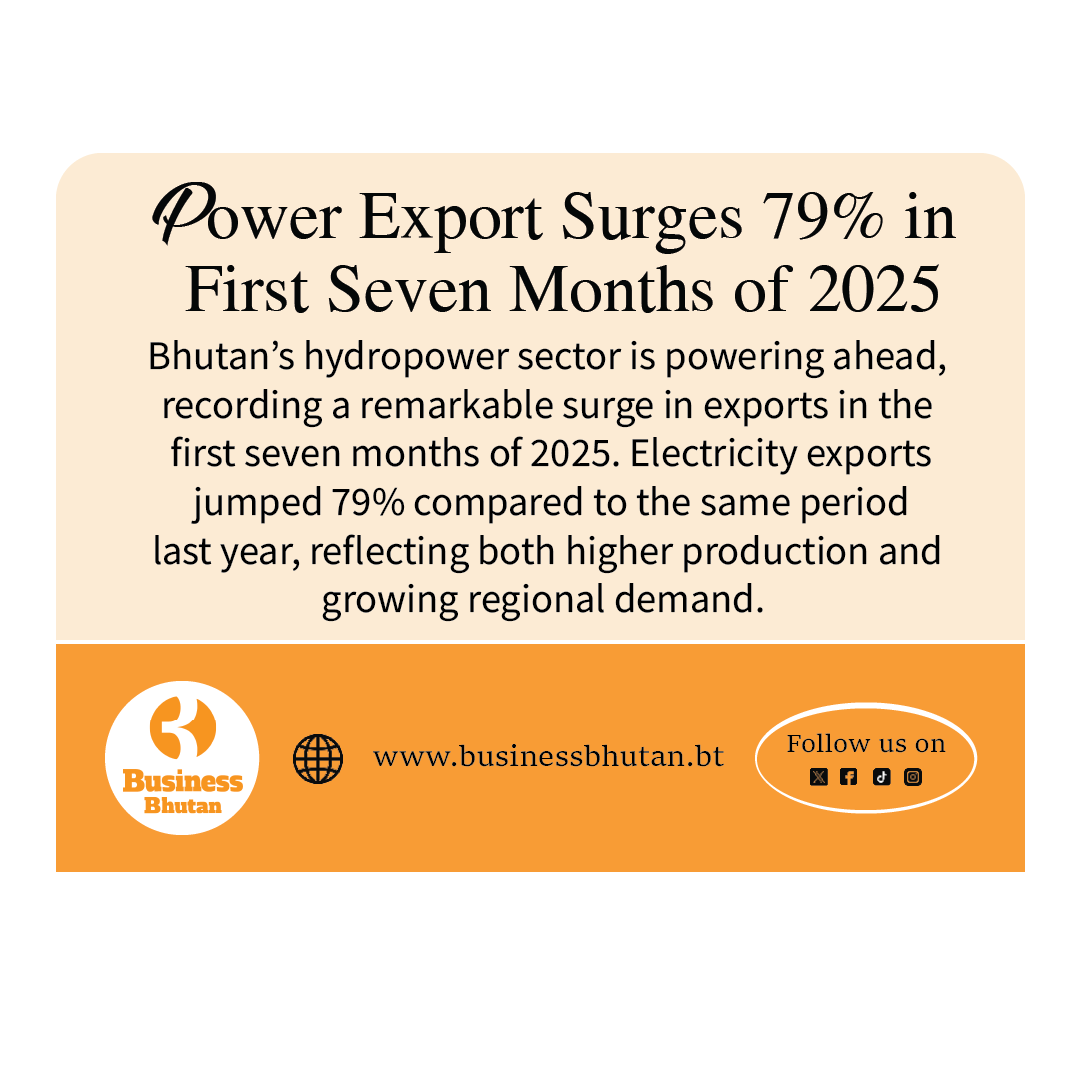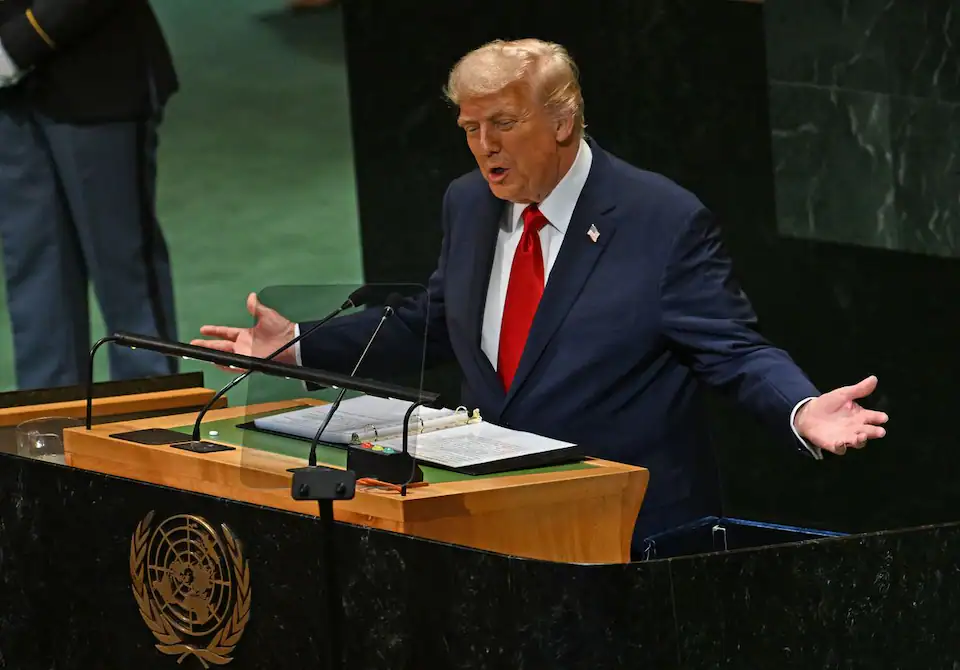Copyright businessbhutan

Bhutan’s hydropower sector is powering ahead, recording a remarkable surge in exports in the first seven months of 2025. Electricity exports jumped 79% compared to the same period last year, reflecting both higher production and growing regional demand. According to the Royal Monetary Authority’s (RMA) monthly statistical bulletin, Bhutan exported electricity worth Nu 11.7 billion through July, sharply up from Nu 6.5 billion in the first seven months of 2024—an increase of approximately Nu 5.1 billion. This surge underscores the strategic importance of hydropower as Bhutan’s largest export earner and a key driver of the nation’s economic growth. The increase is not just a matter of volume; it reflects the country’s strengthened energy infrastructure, optimized generation from multiple hydropower plants, and deepening trade ties with regional partners, particularly India. For a country with a small domestic market, the export of surplus electricity continues to be a vital source of foreign revenue, positioning Bhutan as a reliable regional energy supplier while contributing significantly to the national exchequer. Beyond immediate financial gains, this growth signals Bhutan’s capacity to leverage its natural resources efficiently and sustainably, supporting broader goals of economic diversification, regional integration, and long-term energy security. The trend also highlights the sector’s potential to attract investment, foster innovation in grid management, and further integrate renewable energy solutions into the national and regional energy mix. Drivers of Growth The surge in export earnings is largely attributed to higher generation from the Mangdechhu Hydropower Authority (MHPA), which alone contributed nearly Nu 6 billion in export revenue. The Tala Hydropower Plant (THP) followed with Nu 2.3 billion, while the Chhukha Hydropower Plant (CHP) accounted for Nu 1.7 billion. Other plants—Basochhu, Nikachhu, Dagachhu, and Kurichhu—collectively added another Nu 1.6 billion. On the production side, July was the most productive month, generating 1,751 million units (MU) of electricity, followed by 1,354 MU in June and 926 MU in May. In the January–July period, THP topped generation with 2,089 MU, followed by MHPA with 1,723 MU, and CHP with 888 MU. Dagachhu produced the least, at 182 MU. Domestic Sales Decline While Bhutan’s hydropower exports soared, revenue from domestic electricity consumption declined sharply, highlighting a contrasting trend within the sector. The Royal Monetary Authority (RMA) reported that between January and July 2025, Bhutan earned Nu 3.7 billion from domestic sales—down from Nu 6.2 billion during the same period in 2024, representing a shortfall of nearly Nu 2.5 billion. The decline was most pronounced in the April–June period, when revenue from local consumption fell from Nu 3.5 billion in 2024 to just Nu 1.6 billion in 2025. Analysts attribute this drop to a combination of factors, including lower seasonal demand, shifts in consumption patterns, and possibly delayed payments or adjustments in tariff structures. From a strategic perspective, this trend underscores the need to balance export-oriented growth with domestic energy management. While exports generate valuable foreign revenue, the domestic sector remains critical for supporting industries, households, and overall economic activity. A sustained decline in local revenue could affect utility cash flows and investment in grid maintenance, highlighting the importance of efficient demand forecasting, dynamic pricing, and infrastructure planning. Despite the dip in domestic earnings, the overall picture remains positive: Bhutan’s hydropower sector continues to be a dual engine of economic growth, combining robust export performance with the potential to stabilize and optimize domestic energy use. Stakeholders, including policymakers and energy planners, are now focusing on strategies to revive domestic sales while maintaining strong export momentum, ensuring that the sector delivers balanced economic and social benefits. Strategic Partnership with India India remains Bhutan’s most important energy partner, absorbing the bulk of its surplus electricity. The Ministry of Foreign Affairs and External Trade (MoFAET) highlighted that in 2020, Bhutan’s total trade with India was valued at Nu 94.89 billion (including electricity), representing 82% of Bhutan’s total external trade. Excluding electricity, trade stood at Nu 67.18 billion, or 77% of the total. Looking ahead, the partnership is set to deepen. Under the Power Sale Agreement (PSA), Bhutan will be able to import up to 2,000 MW of electricity from PTC India Ltd. during the lean season of 2025–2026. Earlier this month, Druk Green Power Corporation (DGPC) and PTC India also signed an agreement to implement a new hydropower project in Bhutan, reinforcing a relationship that has enabled the seamless exchange of electricity between the two countries for over 25 years. The Bigger Picture Hydropower remains Bhutan’s single largest export and a cornerstone of its longstanding economic partnership with India, underpinning both revenue generation and regional cooperation. The 79% surge in electricity export revenues in the first seven months of 2025 not only bolsters Bhutan’s external trade balance but also reinforces the country’s position as a reliable energy supplier in South Asia. This performance demonstrates how Bhutan’s abundant renewable resources can be leveraged to strengthen both economic stability and geopolitical ties. At the same time, the decline in domestic electricity sales—down nearly Nu 2.5 billion compared to the same period last year—signals shifting consumption patterns and points to the critical need for effective management of supply and demand. While export markets provide substantial foreign earnings, domestic energy remains vital for households, industries, and overall economic development. Ensuring that domestic consumers have access to affordable and reliable power while meeting growing export commitments presents a delicate balancing act for policymakers and energy planners. Looking ahead, Bhutan’s hydropower sector is poised to remain both a key growth engine and a strategic national asset. Rising electricity demand in India, coupled with expanding regional energy integration, offers significant opportunities for export expansion and revenue growth. At the same time, the sector faces the dual challenge of safeguarding domestic supply, maintaining grid reliability, and investing in sustainable infrastructure. The path forward will require strategic planning, investment in modernized energy management systems, and careful alignment of exports with domestic priorities to ensure that Bhutan’s hydropower remains a sustainable, resilient, and economically transformative resource for years to come. Sherab Dorji From Thimphu



